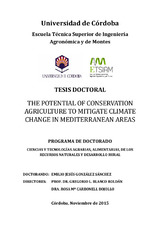The potential of conservation agriculture to mitigate climate change in mediterranean areas
Autor
González Sánchez, Emilio Jesús
Director/es
Blanco Roldán, Gregorio L.Carbonell Bojollo, Rosa M.
Editor
Universidad de Córdoba, UCOPressFecha
2016Materia
Cambio climáticoAgricultura de conservación
Calidad de los suelos
CO2
Emisiones - Reducción
METS:
Mostrar el registro METSPREMIS:
Mostrar el registro PREMISMetadatos
Mostrar el registro completo del ítemResumen
Agriculture contributes to climate change, and is affected by it. On the one hand,
solar energy is used primarily by photosynthetic organisms which transform it into
carbohydrates, releasing oxygen (O2) whilst consuming carbon dioxide (CO2) and
water. In inland areas, agriculture and forestry favor photosynthesis which is
performed by plants and trees; that is how this chemical reaction that sustains life
is generated. On the other hand, several agricultural activities, for example soil
tillage and fertilization of crops, favor the emission into the atmosphere of
greenhouse gases (GHG), such as CO2 and nitrous oxide (N2O). Therefore, the role of
agriculture is twofold: as crops and trees consume some of the CO2 in the
atmosphere for photosynthetic reactions, and agricultural field tasks emit GHG. In
other words, with regards to climate change, agriculture is part of the problem, but
it is also part of the solution.
Currently, about 9% of total GHG emissions in the European Union come from
agriculture, which is considered a net emitter of greenhouse gases. However,
agriculture has an asset that no other productive sector may boast: the soil. There
are various scientific studies that warn of the precarious situation of soils in areas
where the intensification of agriculture has led to intensive tillage as a conventional
practice to prepare the seedbed. In addition, there are numerous studies which
confirm how, through conservation, agriculture soil quality is considerably
improved, and that a sustainable use of soils can be achieved.
The term “sustainable” is used in almost all areas related to agriculture and the
environment. It is a word not only appealing to non-specialists, but also for scientists
and technicians in the field. The overuse of terms related to sustainability has
produced misunderstandings, such as some specific benefits of particular
agricultural systems being wrongly attributed to others. The scientific literature
confirms that not all agricultural practices have an equal impact on the environment... La agricultura contribuye al cambio climático y se ve afectada por él. La energía solar
es utilizada en primer lugar por los organismos fotosintéticos que la transforman
consumiendo dióxido de carbono (CO2) y agua, liberando oxígeno (O2) y generando
hidratos de carbono. En las zonas continentales, gracias a la agricultura y la
silvicultura, mediante la fotosíntesis que realizan las plantas y árboles se genera esta
reacción química que sustenta la vida. Por otra parte, diversas actividades agrícolas,
como el laboreo del suelo y la fertilización de los cultivos, favorecen la emisión a la
atmósfera de gases de efecto invernadero como el CO2 y el óxido nitroso (N2O). Por
tanto, en el sector agrario se presenta la doble vertiente de, por un lado, consumir
parte del CO2 presente en la atmosfera para las reacciones fotosintéticas, y por otro
lado, emitir también gases de efecto invernadero debido a las tareas propias del
ámbito agrario. En otras palabras, la agricultura es parte del problema pero también
parte de la solución al reto del cambio climático.
Actualmente, alrededor del 9% del total de las emisiones de gases de efecto
invernadero de la UE provienen de la agricultura, por lo que se considera un sector
emisor neto de gases de efecto invernadero. No obstante, la agricultura tiene un
activo que ningún otro sector productivo posee: el suelo. No son pocos los estudios
científicos que alertan de la precaria situación de los suelos en zonas donde la
intensificación de la agricultura ha conllevado el laboreo intensivo como práctica
convencional. Afortunadamente, no son pocos los estudios que confirman cómo a...

